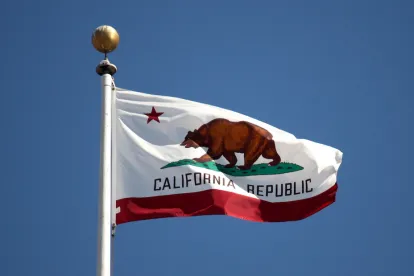This advisory summarizes new legislation in California, titled, “Preserving Access to Affordable Drugs,” which aims to establish a different standard for determining whether a patent settlement violates antitrust laws. This new legislation applies significantly to brand and generic pharmaceutical companies, which often resolve patent litigation under the Hatch-Waxman Act. Our attorneys outline how it differs from the US Federal Trade Commission’s (FTC) enforcement policies, federal antitrust principles and court decisions.
Until recently, balancing tensions between patent and antitrust law has taken stage mostly at the federal level. In the pharmaceutical space, an area of heightened tension involves patent litigation settlements executed between “brand” and “generic” pharmaceutical companies to resolve Hatch-Waxman patent litigation disputes. The US Federal Trade Commission (FTC) is the agency actively policing these agreements, receiving copies as mandated by statute and enforcing through administrative proceedings or the federal courts.
In FTC v. Actavis, the Supreme Court rejected the FTC’s request for application of a quick-look analysis, instead establishing the rule of reason as appropriate.1 In an initial settlement with Teva2 sprouting from the In re Modafinil litigation, the FTC established a template for what it considered to qualify, or not qualify, as a potential reverse payment.3 In a second settlement with Teva and administrative enforcement,4 the FTC further clarified what it believed qualified as a payment, especially in relation to no-AG clauses (they are) and fair value payments for related goods (they are not). While by no means fully vetted, these and other FTC wins, losses, published guidance and settlements at least provided a high-level roadmap that practitioners in the space can consult in determining whether a patent settlement may qualify as an anticompetitive reverse payment agreement.
Practitioners have also had to consider Hatch-Waxman patent settlements under state antitrust laws. But, for the most part, state law was used to expand the type of plaintiff, e.g., end-payor, who could recover damages. The question of whether a given agreement violated the antitrust laws was largely the same. And then came California. California enacted a first-of-its-kind legislation that purports to establish a potentially different standard for determining whether a patent settlement violates the antitrust laws. While the California legislation follows some aspects of positions taken by the FTC, it differs from more recent FTC pronouncements and court decisions in notable ways. This new law is significant for both brand and generic pharmaceutical companies that frequently resolve patent litigation under the Hatch-Waxman Act. Below, we summarize the new legislation and try to outline some ways in which it might differ from FTC enforcement policies and federal court decisions.
California’s “Preserving Access to Affordable Drugs” Legislation
On January 1, 2020, California enacted a new law, titled, “Preserving Access to Affordable Drugs” (herein, the Act). The Act seeks to restrain reverse payment patent settlements (or so-called “pay-for-delay” settlements) associated with Hatch-Waxman pharmaceutical patent litigation. There are several aspects of the Act that may differ from FTC and federal antitrust principles in determining whether a violation exists, including: (1) a presumption that the existence of a payment makes the agreement anticompetitive; (2) a potentially broader definition of what constitutes an offending payment; and (3) the novel calculation of the recognized exclusion of saved litigation costs being considered a payment. The Act also has provisions for punishment that may differ from federal law.
Presumed to be Anticompetitive
As a practical matter, the procedure employed in an antitrust action is of critical importance. Because of the intense and expensive nature of discovery in these actions and significant exposure to damages, if a company cannot defeat a claim early, it will often incur significant costs regardless of the ultimate merits. The Act alters the course of an antitrust action. It creates a presumption that settlements are anticompetitive if: (1) the generic company receives anything of value from the brand company; and (2) the generic agrees to limit or forego research, development, manufacturing, marketing or sales of the generic product for any period of time.5 Once established, the burden shifts to the parties to rebut the presumption by establishing, by a preponderance of the evidence, that either: (1) the value received is fair and reasonable compensation solely for other goods or services that the generic company has promised to provide; or (2) the agreement has directly generated procompetitive benefits, and those procompetitive benefits outweigh the anticompetitive effects of the agreement.
The Act’s procedural framework is a marked difference from that applied by the federal courts in determining violations of the Sherman Act — the rule of reason. California, essentially, legislates the quick look analysis pursued by the FTC, but rejected by the Supreme Court, in Actavis. Notably, the Act also differs from the structured rule of reason test previously espoused by the California Supreme Court in In re Cipro Cases I & II.6 This legislation transforms the flexible nature of the rule of reason analysis set forth in Actavis into a test more onerous on brand and generic companies, which creates a substantial risk of increasing costs regardless of the underlying merits of a claim.
Defining “Anything of Value”
The Act does not explicitly define what would constitute an offending payment but states it is whenever a generic company receives “anything of value” from the company asserting patent infringement. The Act does provide some parameters around what qualifies as “anything of value.” It definitively includes exclusive licenses and promises that the brand company will not launch an authorized generic version of its brand drug (a “no-AG agreement”). It specifically excludes provisions that are de rigueur in Hatch-Waxman settlements, including licenses to market before expiration of patents, covenants not to sue, acceleration clauses based on the reference drug holder marketing a different dosage or form of the drug, waiver of damages from an at-risk launch and future litigation costs. But other than the explicit exceptions, it is unclear how California courts will define the contours of “anything of value.”
Particularly troubling is that this may create a different standard of what qualifies as a “reverse payment” compared to what has been forming, slowly but surely, under the federal statute. For example, while by no means binding, the FTC’s revised settlement with Teva has provided a blueprint for what the agency finds acceptable. For example, for supply and materials agreements to pass FTC scrutiny, they must meet specific pricing conditions and be the only agreement entered into between the companies during the Exclusion Period.7 It is unclear whether similar fair-price arrangements would qualify as “anything of value” under the California statute, and even if it does on the merits, because of the burden-shifting, it may be difficult to dismiss wanting complaints at the motion to dismiss phase.
Saved Litigation Costs
As discussed above, the Act carves out certain exceptions from anticompetitive scrutiny, including payments made for “saved litigation costs.” Here, the Act attempts to structure how such costs are calculated. To qualify for this exception, both of the following must be true:
-
the total compensation for saved litigation expenses is reflected in budgets that the brand company documented and adopted at least six (6) months before the settlement; and
-
the compensation does not exceed either $7.5 million or five percent of the revenue that the generic company projected or forecasted it would receive in the first three (3) years of sales and documented at least twelve (12) monthsbefore settlement, whichever is lower. If no projections are available, the compensation does not exceed $250,000.
This is an area of concern for many reasons. Most notably, if the companies do not have documentation showing the brand company’s budget and the adoption of that budget, then the parties are limited to an agreement where the compensation does not exceed $250,000. It goes without saying that $250,000 bears little relation to the actual litigation budget of a brand in a pharmaceutical case, regardless of whether such is in a formal budget.
The Act’s requirement may also create substantial procedural hurdles to substantiate compliance. For example, the brand’s litigation budget is not something that is generally shared with the generic. So, how does the generic ensure compliance when a proposed settlement includes saved litigation costs? Is a representation or warranty sufficient? Other variables abound. A brand might have an alternative fee arrangement with contingencies built on case results. A brand might have a total budget for a number of consolidated cases that is not broken out per generic company. Similarly, depending on the issues of a case and the timing of settlement discussions, a generic might not have produced all of its forecasts to the brand. Further, it is not uncommon for a generic company to have either multiple forecasts or multiple scenarios within a forecast, with different assumptions on market conditions that yield substantially different expected profits. In such cases, which forecasted number is considered? In comparison, the FTC Settlement provides a maximum limit of $7 million. There is no requirement of specific documentation. And while the FTC has not expressly stated that amounts under $7 million are necessarily non-problematic, there has been a general enforcement policy that, so long as the payment is reasonable, it is not going to be second-guessed in an aggressive manner.
Different Remedy
The Act allows for substantial penalties to be levied against would-be offenders —permitting the California Attorney General to recover “an amount up to three times the value received by the party that is reasonably attributable to the violation,8 or $20,000,000, whichever is greater.” There is also some concern as to whether the Act could allow for private damages under the Cartwright Act, which is California’s primary antitrust law. While the Act limits recovery to the Attorney General, it also states that it does not modify the applicability of the antitrust laws of California and that “[e]ach party that violates or assists in the violation of this section shall be liable for any damages, penalties, costs, fees, injunctions, or other remedies” available under the existing antitrust laws. The applicability of the Act to private damages will remain unclear until the California legislation speaks to this issue, or it is the subject of litigation within the courts.
Developments to Monitor
In November 2019, the Association for Accessible Medicines (AAM), a group of generic pharmaceutical companies and suppliers, filed a lawsuit against the California Attorney General challenging the constitutionality of the Act and seeking to enjoin its implementation.9 AAM included in its allegations that the Act violates the Dormant Commerce Clause, by regulating transactions that take place outside of California, and the Act’s burden-shifting regime violates the AAM members’ procedural due process rights.10 The district court judge denied the motion for injunction, finding that the law was not facially invalid and the challenge was not yet ripe for assessment since AAM had not sufficiently shown that the Act would likely be enforced against agreements entered into outside of California.11 AAM appealed the district court’s decision to the Ninth Circuit. The appeal is currently in briefing and under consideration for an upcoming oral argument calendar in July 2020.12
1 FTC v. Actavis, Inc., 570 US 136 (2013).
2During the course of that litigation, Teva had purchased the brand Cephalon which may have allowed the FTC to bind Teva in a combined settlement.
3See Stipulated Revised Order for Permanent Injunction and Equitable Monetary Relief, FTC v. Cephalon Inc., 2:08-cv-02141 (E.D. Pa. Feb. 19, 2019). This document has a first and second settlement with Teva, the latter referred to herein as the Final FTC Teva Settlement.
4Impax Labs., Inc. v. FTC, 19-cv-60394 (5th Cir. June 7, 2019).
5 The latter element is presumably going to be met routinely because it seems to include any settlement whereby the generic company does not launch its product as soon as it can regardless of the patent.
6 In re Cipro Cases I & II, 61 Cal. 4th 116, 348 P.3d 845 (2015).
7 The “Exclusion Period” is defined as the 60-day period starting 30 days before executing the settlement agreement and ending 30 days after execution.
8 The value that is “reasonably attributed to the violation” is determined by California’s share of the market for the given brand drug.
9 Ass’n for Accessible Medicines v. Becerra, Case No. 2:19-cv-2281 (E.D. Cal. Nov. 11, 2019).
10Id. Dkt. No. 2 at 18-27; 44.
11 Id. Dkt. No. 29 at 7-10.
12 Ass’n for Accessible Medicines v. Becerra, Case No. 20-15014 (9th Cir. Jan. 6, 2020).







 />i
/>i

